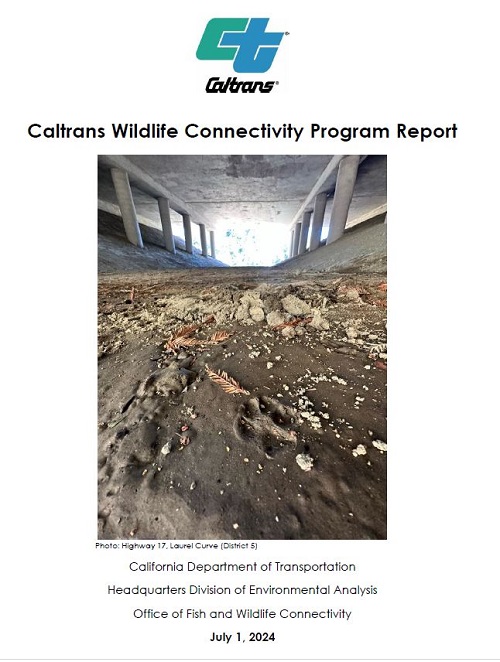Fish and Wildlife Connectivity
The Caltrans Headquarter Fish and Wildlife Connectivity Office implements fish passage and wildlife connectivity legislative requirements statewide and manages the Fish and Wildlife Connectivity State Highway Operation and Protection Program (SHOPP). This includes development of the priority inventory of fish and wildlife barriers for remediation through statewide studies, research, and partnerships. The Fish and Wildlife Connectivity Program supports internal and external collaboration on science and data, engineering, funding, project delivery, remediation, and effectiveness monitoring.
The State Highway System (SHS) currently offers some opportunities for aquatic and terrestrial species migration and provides some access to high quality habitat for threatened and endangered, as well as listed species. However, there are many statewide opportunities to improve connectivity and identify where high priority connectivity improvements are needed.
Regulations and requirements for fish and wildlife connectivity, under Streets and Highways Code.
Fish Passage - Streets and Highways Code 156 (SB 857), Division 1, Chapter 1, Article 3.5, became effective January 1, of 2006.
Streets and Highways Code requires the Department to assess, prioritize, fund, and remediate barriers on the SHS for salmon and steelhead. Annual reports to Legislature are required to report the status of the department’s progress in locating, assessing, and remediating barriers to fish passage to include detail on barrier assessments, active and planned remediation projects, priority fish passage barriers, designated funding, and completed fish passage remediations.
Wildlife Connectivity - Streets and Highways Code 158 (AB 2344), Division 1, Chapter 1, Article 3.8, became effective January 1, of 2022.
Streets and Highways Code requires the Department to assess, prioritize, fund, and remediate barriers on the SHS for wildlife. Reports to Legislature are required to provide a status of the department’s progress in locating, assessing, and remediating barriers to wildlife connectivity to include details on barrier assessments, active and planned remediation projects, priority wildlife barriers, engineering guidance updates, designated funding, and completed wildlife connectivity barrier remediations.
Fish Passage Advisory Committees (FishPAC)
The FishPAC is a joint effort between the California Department of Transportation (Caltrans), California Department of Fish & Wildlife (CDFW), National Marine Fisheries Service (NMFS), U.S. Fish & Wildlife Service (USFWS), and other advocates of fish passage remediation and watershed restoration efforts.
FishPACs prioritize barriers to fish passage and support project delivery and implementation of meaningful, long-term solutions for funding and barrier remediation within each FishPAC geographic area. FishPACs recommend technical solutions, explore options for accelerated delivery of permits and projects, and identify potential funding opportunities for barrier remediation projects. FishPACs track the status of active and funded fish passage barriers until they are remediated, to include post-construction monitoring for remediation effectiveness. FishPAC highest priority for remediation solutions are full-span and stream simulation designs solutions that connect high quality habitat for fish, other aquatic species, and terrestrial wildlife.
For more information, visit the FishPAC website.
FishPACs advance the remediation of fish passage barriers on the State Highway System, and promote collaborative interjurisdictional solutions, to ensure that barriers are assessed and documented prior to project planning and initiation.
Check the Fish Passage story map to review active, priority, & completed fish passage locations.
Wildlife Connectivity
Caltrans is the owner of more property within California than any other landowner. The State Highway System (SHS) crosses all areas of California, bisecting important habitats for aquatic and terrestrial species, many of which are listed as threatened or endangered under the state/federal endangered species acts. California has the second largest number of endangered species (after Hawaii), surpassing most other states by a significant margin. Threatened and endangered species in California tend to be smaller bodied species (e.g., amphibians and reptiles), which do not pose a safety risk to the traveling public. If recovery of threatened and endangered species is possible in California, Caltrans will need to play a significant role in connecting habitats that have been bisected by the SHS, which would improve species resiliency to drought, wildfire, and climate change.
View the map to see the Priority Wildlife Connectivity Barriers 2024.
Hot Spots and Animal/Vehicle Collisions
As lanes have been added to the SHS and traffic has increased, roadkill rates have also continually increased. Hot spot roadkill areas have been documented on virtually every route in the state, the majority of which correlate with threatened and endangered species habitat areas and ranges of managed herds or fully protected species.
News

Caltrans Wildlife Connectivity Program Report July 1, 2024 (PDF)

